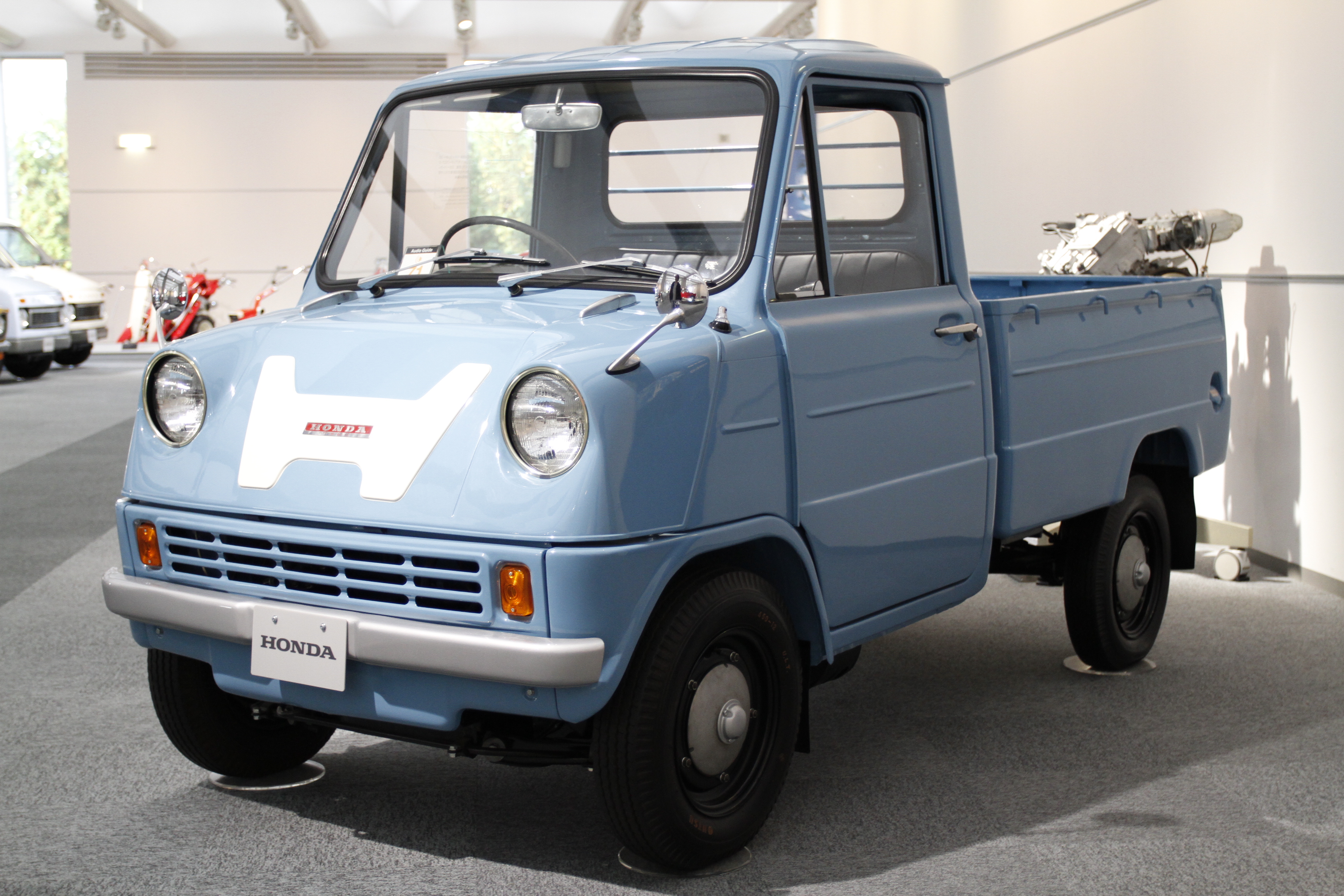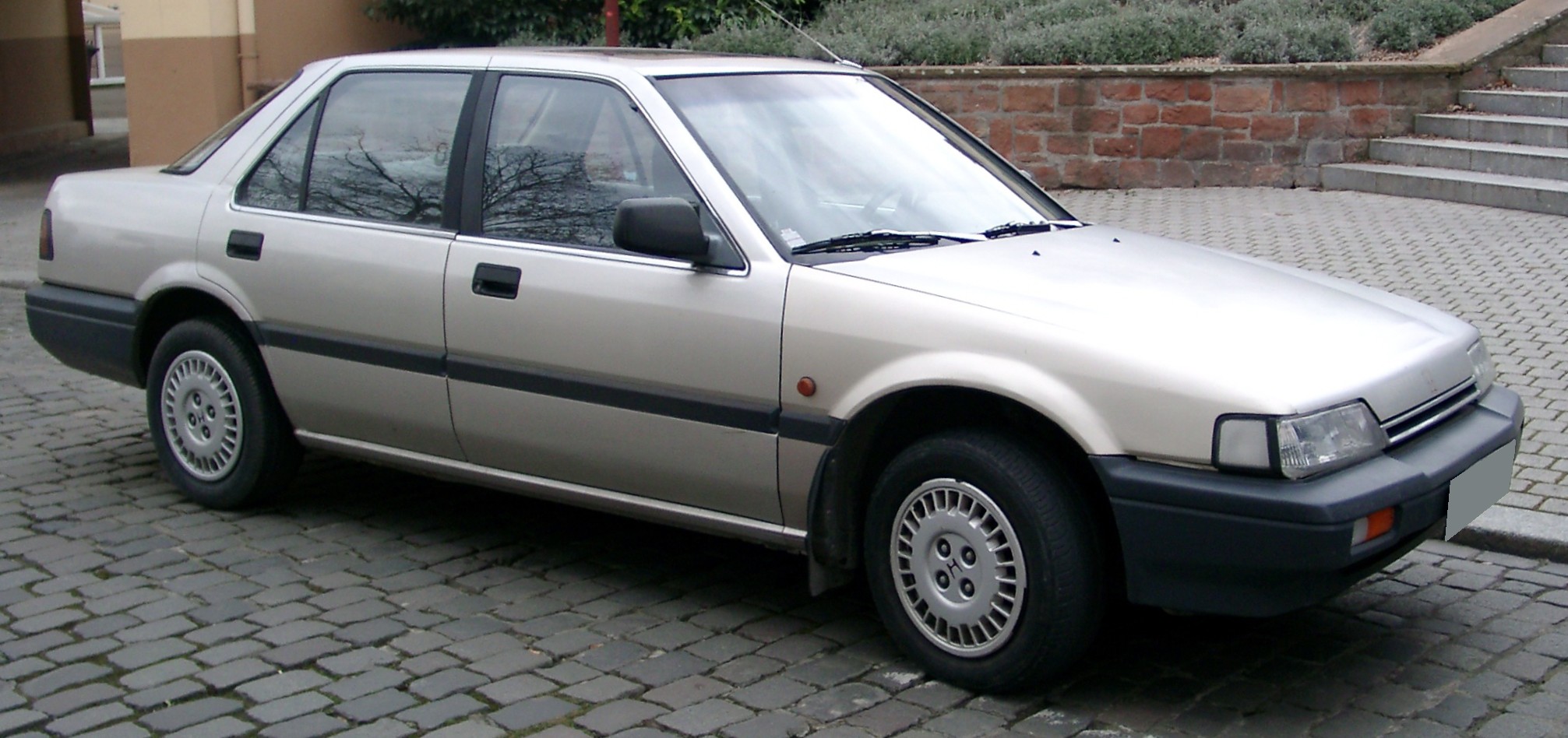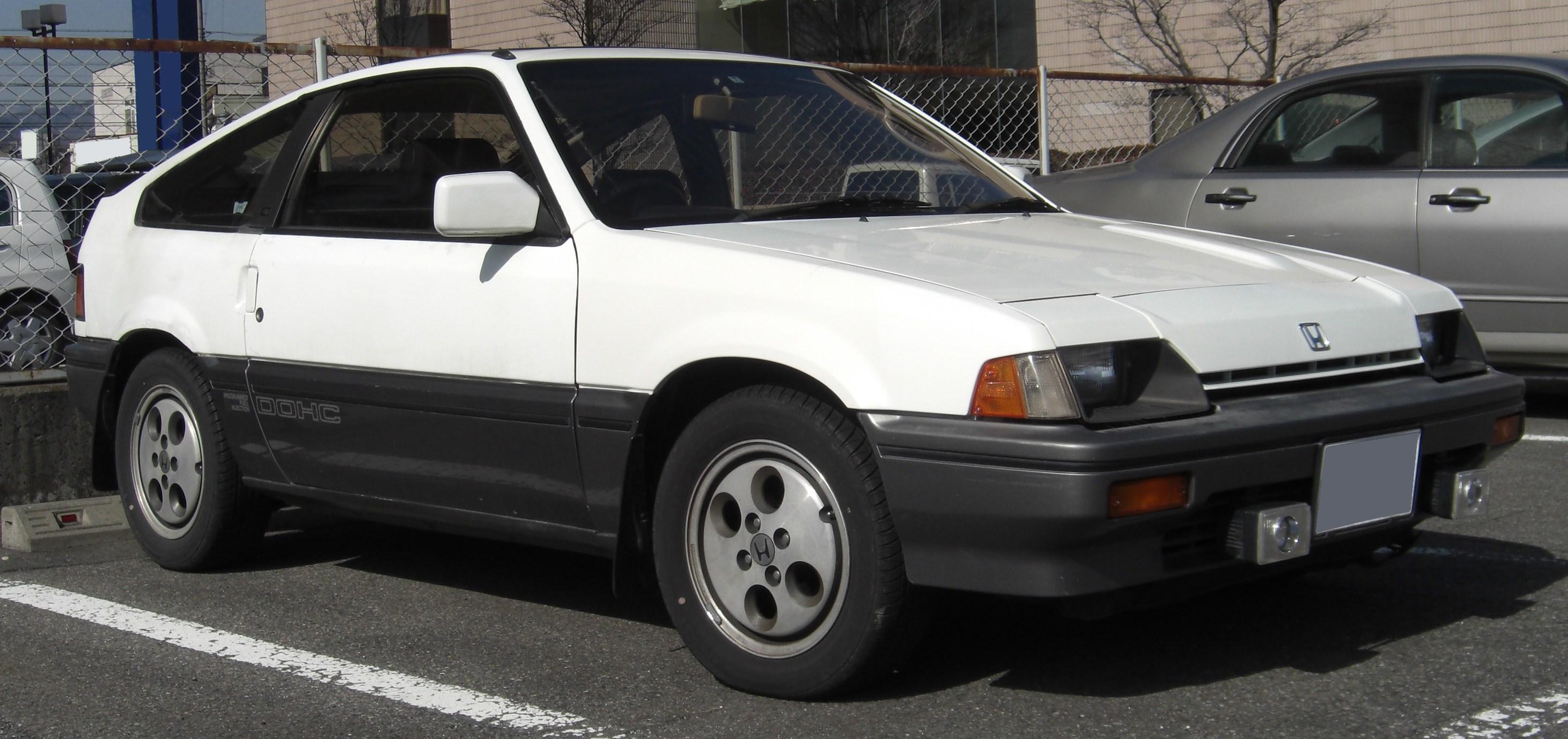|
Honda Civic (second Generation)
The second-generation Honda Civic is an automobile produced by Honda from 1979 until 1983. It debuted in June 1979 with a more angular shape, increased engine power, and larger dimensions in all models. The design was closer aligned to its larger sister, the Accord and the car was generally more comfortable and sophisticated than the first generation Honda Civic. Design The wheelbase now measured for the hatchback (the fastback sedan was no longer available) and for the wagon, 3-box design sedan, as well as the later five-door hatchback. The 1300 or 1500 cc Civic engines came in cross flow and CVCC design depending on the market they were sold in. In some countries, a 1170 cc EN3 engine was available as a base option. Three transmissions were offered: a four-speed manual (on base models), a five-speed manual, a two-speed Hondamatic, and then from 1981 a three-speed automatic. North America In North America, the Civic 1300 and 1500 both came in base and DX version ... [...More Info...] [...Related Items...] OR: [Wikipedia] [Google] [Baidu] |
Honda
is a Japanese public multinational conglomerate manufacturer of automobiles, motorcycles, and power equipment, headquartered in Minato, Tokyo, Japan. Honda has been the world's largest motorcycle manufacturer since 1959, reaching a production of 400 million by the end of 2019, as well as the world's largest manufacturer of internal combustion engines measured by volume, producing more than 14 million internal combustion engines each year. Honda became the second-largest Japanese automobile manufacturer in 2001. In 2015, Honda was the eighth largest automobile manufacturer in the world. Honda was the first Japanese automobile manufacturer to release a dedicated luxury brand, Acura, in 1986. Aside from their core automobile and motorcycle businesses, Honda also manufactures garden equipment, marine engines, personal watercraft, power generators, and other products. Since 1986, Honda has been involved with artificial intelligence/robotics research and released their ASIMO rob ... [...More Info...] [...Related Items...] OR: [Wikipedia] [Google] [Baidu] |
Station Wagon
A station wagon ( US, also wagon) or estate car ( UK, also estate), is an automotive body-style variant of a sedan/saloon with its roof extended rearward over a shared passenger/cargo volume with access at the back via a third or fifth door (the liftgate or tailgate), instead of a trunk/boot lid. The body style transforms a standard three-box design into a two-box design — to include an A, B, and C-pillar, as well as a D-pillar. Station wagons can flexibly reconfigure their interior volume via fold-down rear seats to prioritize either passenger or cargo volume. The ''American Heritage Dictionary'' defines a station wagon as "an automobile with one or more rows of folding or removable seats behind the driver and no luggage compartment but an area behind the seats into which suitcases, parcels, etc., can be loaded through a tailgate." When a model range includes multiple body styles, such as sedan, hatchback, and station wagon, the models typically share their platform, d ... [...More Info...] [...Related Items...] OR: [Wikipedia] [Google] [Baidu] |
Honda CIVIC COUNTRY In The Honda Collection Hall
is a Japanese public multinational conglomerate manufacturer of automobiles, motorcycles, and power equipment, headquartered in Minato, Tokyo, Japan. Honda has been the world's largest motorcycle manufacturer since 1959, reaching a production of 400 million by the end of 2019, as well as the world's largest manufacturer of internal combustion engines measured by volume, producing more than 14 million internal combustion engines each year. Honda became the second-largest Japanese automobile manufacturer in 2001. In 2015, Honda was the eighth largest automobile manufacturer in the world. Honda was the first Japanese automobile manufacturer to release a dedicated luxury brand, Acura, in 1986. Aside from their core automobile and motorcycle businesses, Honda also manufactures garden equipment, marine engines, personal watercraft, power generators, and other products. Since 1986, Honda has been involved with artificial intelligence/robotics research and released their ASIMO r ... [...More Info...] [...Related Items...] OR: [Wikipedia] [Google] [Baidu] |
Honda Accord
The , also known as the in Japan and China for certain generations, is a series of cars manufactured by Honda since 1976, best known for its four-door sedan variant, which has been one of the best-selling cars in the United States since 1989. The Accord nameplate has been applied to a variety of vehicles worldwide, including coupes, station wagons, hatchbacks and a Honda Crosstour crossover. Since its initiation, Honda has offered several different car body styles and versions of the Accord, and often vehicles marketed under the Accord nameplate concurrently in different regions differ quite substantially. It debuted in 1976, as a compact hatchback, though this style only lasted through 1989, as the lineup was expanded to include a sedan, coupe, and wagon. By the sixth-generation Accord at the end of the 1990s, it evolved into an intermediate vehicle, with one basic platform but with different bodies and proportions to increase its competitiveness against its rivals in diffe ... [...More Info...] [...Related Items...] OR: [Wikipedia] [Google] [Baidu] |
Automobile
A car or automobile is a motor vehicle with Wheel, wheels. Most definitions of ''cars'' say that they run primarily on roads, Car seat, seat one to eight people, have four wheels, and mainly transport private transport#Personal transport, people instead of cargo, goods. The year 1886 is regarded as the birth year of the car, when German inventor Carl Benz patented his Benz Patent-Motorwagen. Cars became widely available during the 20th century. One of the first cars affordable by the masses was the 1908 Ford Model T, Model T, an American car manufactured by the Ford Motor Company. Cars were rapidly adopted in the US, where they replaced Draft animal, animal-drawn carriages and carts. In Europe and other parts of the world, demand for automobiles did not increase until after World War II. The car is considered an essential part of the Developed country, developed economy. Cars have controls for driving, parking, passenger comfort, and a variety of lights. Over the decades, a ... [...More Info...] [...Related Items...] OR: [Wikipedia] [Google] [Baidu] |
Honda Civic (third Generation)
The third-generation Honda Civic is an automobile which was produced by Honda from 1983 until 1987. It was introduced in September 1983 for model year 1984. The Civic's wheelbase was increased by 2–5 inches (13 cm) to 93.7 inches (hatchback) or 96.5 inches (sedan). A three-door hatchback/kammback, four-door sedan (also known as the Honda Ballade), the five-door "Shuttle" station wagon, and sporting CRX coupé shared common underpinnings. This included MacPherson strut suspension with torsion bars in the front and a rear beam with coil springs. However, the body panels were largely different between models. The Civic-based Honda Quint five-door hatchback also underwent a model change, and became the Honda Quint Integra, available as both a three- and five-door fastback. The Quint Integra (soon just "Integra") was sold at the Japanese ''Honda Verno'' dealership along with the CR-X. The Civic in Japan was now exclusive to ''Honda Primo'', along with Honda's kei cars as w ... [...More Info...] [...Related Items...] OR: [Wikipedia] [Google] [Baidu] |
Honda Civic (first Generation)
The first-generation Honda Civic is an automobile that was produced by Honda in Japan from July 1972 until 1979. It was their first genuine market success, eschewing the air-cooling and expensive engineering solutions of the slow-selling Honda 1300 and being larger than the minuscule N-series. The Civic laid down the direction Honda's automobile design has followed since. Model year changes The Civic was largely developed as a new platform, and was the result of taking the previous Honda N600 and increasing the length, width, height and wheelbase. The engine displacement was almost double the N600 at , with two more cylinders and mounted transversely while using water cooling, benefiting from lessons learned from the Honda 1300. The straight-four engine produced roughly and standard features included power front disc brakes, vinyl seating, reclining bucket seats, and a woodgrain-accented dashboard. The hatchback version added a fold-down rear seat, an AM radio, and cloth up ... [...More Info...] [...Related Items...] OR: [Wikipedia] [Google] [Baidu] |
Automatic Transmission
An automatic transmission (sometimes abbreviated to auto or AT) is a multi-speed transmission used in internal combustion engine-based motor vehicles that does not require any input from the driver to change forward gears under normal driving conditions. It typically includes a transmission, axle, and differential in one integrated assembly, thus technically becoming a transaxle. The most common type of automatic transmission is the hydraulic automatic, which uses a planetary gearset, hydraulic controls, and a torque converter. Other types of automatic transmissions include continuously variable transmissions (CVT), automated manual transmissions (AMT), and dual-clutch transmissions (DCT). An electronic automatic transmission (EAT) may also be called an electronically controlled transmission (ECT), or electronic automatic transaxle (EATX). A hydraulic automatic transmission may also colloquially called a " slushbox" or simply a "torque converter", although the latter term c ... [...More Info...] [...Related Items...] OR: [Wikipedia] [Google] [Baidu] |
Hondamatic
:''See also list of Honda transmissions for other Hondamatics'' The Hondamatic (also called the H2) was Honda's first semi-automatic transmission. It was produced from 1973 through 1988. The ''Hondamatic'' name continued to be used on fully-automatic transmissions from Honda. Design and Application The original Hondamatic, like all following Honda automatics, featured gears on parallel axes rather than planetary gears like most other automatic transmissions. Each gear continuously meshes, and each gear included a dedicated clutch. The clutches are hydraulically controlled, applying oil pressure to the desired "gear". Shifting between forward gears was done by simply sliding the gear selector (actually a hydraulic valve) from 1 to 2. It did not automatically shift, but because of the torque converter, could be driven entirely in second gear. The Honda automobile torque converter had a lockup, leading the company to sell the original Hondamatic (which had just two forward gear ... [...More Info...] [...Related Items...] OR: [Wikipedia] [Google] [Baidu] |
Manual Transmission
A manual transmission (MT), also known as manual gearbox, standard transmission (in Canada, the United Kingdom, and the United States), or stick shift (in the United States), is a multi-speed motor vehicle transmission (mechanics), transmission system, where gear changes require the driver to manually select the gears by operating a gear stick and clutch (which is usually a foot pedal for cars or a hand lever for motorcycles). Early automobiles used ''sliding-mesh'' manual transmissions with up to three forward gear ratios. Since the 1950s, ''constant-mesh'' manual transmissions have become increasingly commonplace and the number of forward ratios has increased to 5-speed and 6-speed manual transmissions for current vehicles. The alternative to a manual transmission is an automatic transmission; common types of automatic transmissions are the Automatic transmission#Hydraulic automatic transmissions, hydraulic automatic transmission (AT), and the continuously variable transmissio ... [...More Info...] [...Related Items...] OR: [Wikipedia] [Google] [Baidu] |
CVCC
CVCC, or , is an internal combustion engine technology developed and trademarked by the Honda Motor Company. The technology's name refers to its primary features: Compound refers to the use of two combustion chambers; Vortex refers to the vortex generated in the main combustion chamber, increasing combustion speed, and Controlled Combustion refers to combustion occurring in a timely, controlled manner. The engine innovatively used a secondary, smaller auxiliary inlet valve to feed a richer air-fuel mixture to the combustion chamber around the spark plug, while the standard inlet valve fed a leaner air-fuel mixture to the remainder of the chamber, creating a more efficient and complete combustion. History Following the establishment of an "Air Pollution Research Group" by Honda in 1965, its collection of emissions data from American automakers, and subsequent research into emissions control and prechambers, the first mention of CVCC technology was by Soichiro Honda on Fe ... [...More Info...] [...Related Items...] OR: [Wikipedia] [Google] [Baidu] |
Straight-four Engine
A straight-four engine (also called an inline-four) is a four-cylinder piston engine where cylinders are arranged in a line along a common crankshaft. The vast majority of automotive four-cylinder engines use a straight-four layout (with the exceptions of the flat-four engines produced by Subaru and Porsche) and the layout is also very common in motorcycles and other machinery. Therefore the term "four-cylinder engine" is usually synonymous with straight-four engines. When a straight-four engine is installed at an inclined angle (instead of with the cylinders oriented vertically), it is sometimes called a slant-four. Between 2005 and 2008, the proportion of new vehicles sold in the United States with four-cylinder engines rose from 30% to 47%. By the 2020 model year, the share for light-duty vehicles had risen to 59%. Design A four-stroke straight-four engine always has a cylinder on its power stroke, unlike engines with fewer cylinders where there is no power stroke occu ... [...More Info...] [...Related Items...] OR: [Wikipedia] [Google] [Baidu] |


%2C_front_11.30.21.jpg)





